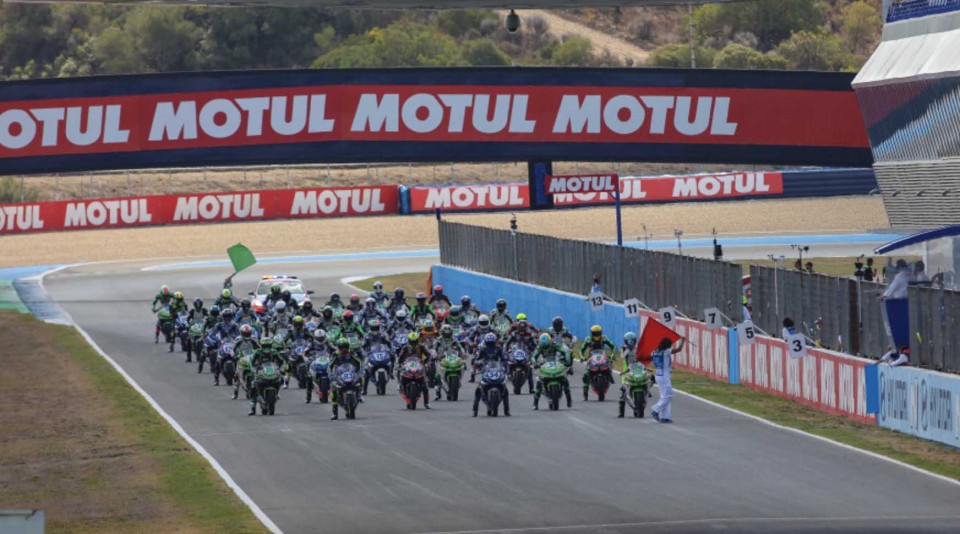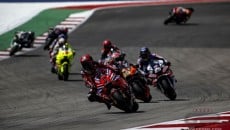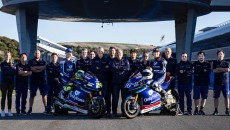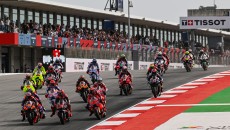I've been following racing for 40 years. The circuits are my home, and I have always felt comfortable there. Yet every time I go into a circuit I always think of Ulysses and the Cyclops. And of the cave where the monster can devour whoever enters it.
There is no contradiction in this thought / nightmare: motorcycle racing is a dangerous sport and over the years, starting from those of production-based racing, passing through the first years of the world championship, I have lost several friends: Tommaso Piccirilli, Sauro Pazzaglia, the former showed me the lines at Vallelunga, with the latter I shared a caravan in the races, in the sense that if it happened, he accomodated me.
Those were the times when Ezio Pirazzini, a colleague from the old days, one of those who didn't ride a bike, wore a scarf, but had lived through the even more heroic times of motorcycling, told me: "either we stop racing or we stop crying" .
He was right, of course, and yet if we take away Michel Rougerie and Patrick Pons, who died as a result of being run over (and tragically united in this fate), I don't remember many other cases of fatal accidents due to riders being run over. The case of Reinhold Roth, in Rijeka, belongs to a different fate.
Yes, it is true, there was Tomizawa in Misano, but only this year we have lost three young guys from the smaller categories in accidents too similar to be a coincidence, defined by my friend Franco Uncini as "inevitable tragedies".
Franco, moreover. He is right, having himself been the victim of a similar event - it was 1983, in Assen and it was Wayne Gardner who hit him - but he miraculously came out of it alive.
I don't blame age, although I don't fully appreciate this wanting to speed up access to racing at all costs. Increasingly young champions add nothing to my passion.
The fact is that today the rules are made more to boost the show than for anything else. And this explains why in every category, from production-based to MotoGP, all classes have frighteningly similar performances.
This obviously serves as a prelude to hard-fought races during which long trains of riders form in each other’s slipstream. All with their noses in the tachometer for a loss of one km/h of top speed, both bikes powered by single-cylinder 50 hp engines and four-cylinder 300 hp ones.
Obviously the more the speed increases, the more talent counts, but that's not the only problem. The fact is that today with 4-stroke engines small errors, of line, of engine use, you don't lose out anymore.
Remember the hissing 2-stroke races? Even if Schwantz, Rainey or Uncini himself were riding, missing a line, braking, entering a corner meant losing the group, in addition to a few seconds. The engine, under torque, did not push and you were left behind.
With the small 50 or 80 cc or the 125, clean riding was a categorical imperative: if you made a mistake, you paid in terms of time. Oh, mind you, there were trains even then, but not 40 carriages!
Banning two-strokes was an unforgivable mistake: they taught you how to ride. I would reintroduce them for the very young. Moreover, they also cost less than four-strokes and are less constant in their performance. Maybe now nobody gives a damn anymore, but they also trained the mechanics.
And then there is also weight. Today an SS300 comes close to 160 kg, and since the performance is what it is, the throttle never closes, so much so that I am surprised that there are so few collisions between the ‘carriages’.
And with 40 riders at the start, it's just a wild bunch from which emerges those who have talent, sure, but also those who have more guts to slip through, fairing to fairing, on the straights. In any case, in the corners the friendly four-stroke engine somehow pulls you through, even if you enter along or off the line.
And then, the inevitable corollary of the pro-show rules I mentioned earlier, the bikes are all the same. Pay attention to this: it is also happening in the most competitive category, MotoGP. Years ago, before you deserved a factory bike, you had to finish in the top five of the world championship, and sometimes that wasn't enough either. There was a difference in performance between Barry Sheene's official Suzuki and the one bought by Uncini’s dealer.
And this rule was valid in all the other displacement categories because you bought a Yamaha 250 and 350 from the dealer and in the 50 and 125 we are talking about almost handcrafted bikes. While young riders (not yet very young) trained at the school of production derivatives. Bikes that when they went well had about ninety horsepower.
So it's true that accidents are inevitable, but it is also true that we are not doing anything to avoid the most stupid ones. Months ago I was talking to Emanuele Pirro, ex-F1, 5 times winner at Le Mans, about the famous, or infamous, green space which, exiting the curve, if you ran over you risked a penalty.
"What I don’t like, apart from the fact that you have to follow the rules - Pirro told me - is that this new situation comes at the expense of clean driving".
Because years ago if you went off a line you ended up on the 'big teeth' of the high curbs and, if you were in a car, you smashed the bottom, on the bike you had to roll off the gas ... you learned to ride, you learned that the gas did not always have to be fully open, so who cares if I go wide! Like hell! You ended up in the gravel and if you were good you remained upright, otherwise you would crash, but the bike rarely returned to the track.
These innovations, let's face it, were introduced not for safety but for the show, like bendy poles in skiing. It is clear that in sport one adapts and changes according to the opportunities: Tomba entered straight with the best line on the pole, the motorcyclist always keeps everything open because at most, whatever may happen, he ends up on the green.
This is the wrong way to approach racing.
We’ve had enough of creating single-make championships that have the same bikes to excel in which you have to learn to race in a different way. Let's take Moto3: the fifth and sixth gear ratios are made, depending on the circuit, based on the slipstreams, to take advantage of the higher speed, so there is even 35 km/h of difference between one gear and another. The riders race always glued on to their opponent's ass thanks to the slipstream. Let’s try to write rules that reward the best. And who cares if instead of a long train, four or five groups of a few riders will form.
And let’s invest more in safety. It took the genius of Lino Dainese, closely followed by Alpinestars to give us leathers with airbags. Let's not stop there. And then, if we don't want to totally deal with the question of age / participation / bike, we make the youngest race not in wild bunches but in heats. Two starts of 20 riders, even fewer. Three incidents with the same dynamics in six months are a wake-up call that it is madness to ignore or underestimate. Look at the photo illustrating this article and try to count the starters. There is nothing else to add.










